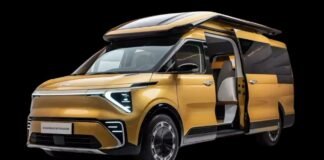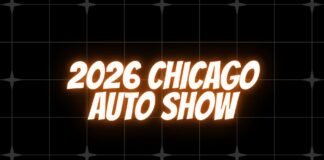Tesla continues to push the boundaries of innovation with the introduction of the 2025 Tesla Model 2 Redwood. Priced at $25,000, this compact hatchback aims to make electric vehicles (EVs) more accessible to a broader audience. Elon Musk recently confirmed that Tesla has not abandoned the Model 2 Redwood project and plans to produce 3 million low-cost cars by 2025.
In this comprehensive blog post, we will explore into everything we know about the Model 2, including its exterior and interior features, manufacturing process, and pricing.
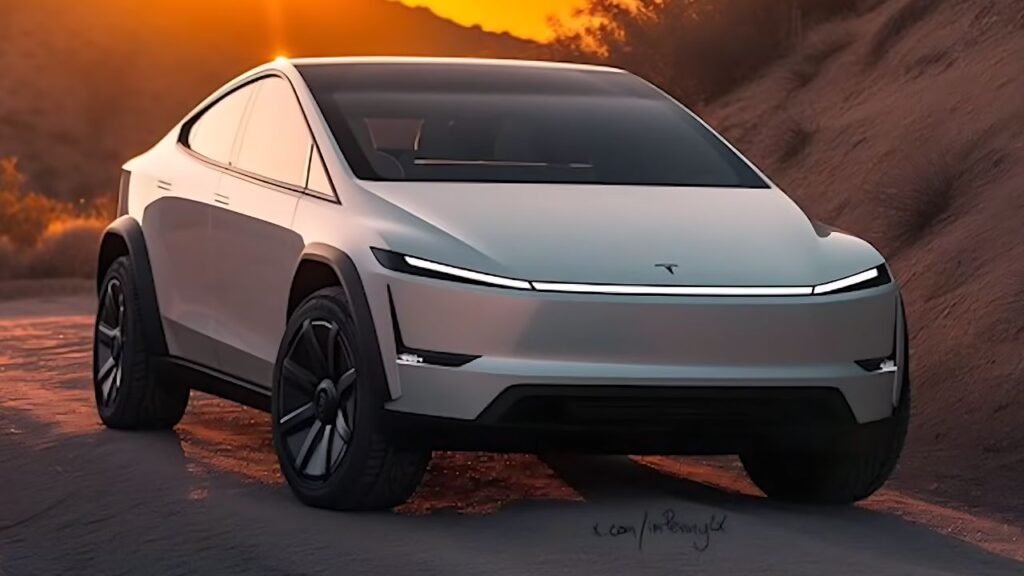
Production Plan: Accelerating Tesla’s Vehicle Lineup
Tesla has updated its future vehicle lineup to expedite the launch of new models, including more affordable options, by the second half of 2025. These new vehicles will incorporate elements from both the Next Generation and current platforms, allowing them to be produced on the same manufacturing lines as Tesla’s existing lineup. Elon Musk has revealed that the Model 2 plan will follow the original timeline, with production set to begin in mid-2025.
The integration of Next Generation and existing platforms will enable manufacturing on the same lines as Tesla’s current vehicles, helping the company reach a production capacity of over 3 million vehicles. In 2023, Tesla successfully delivered more than 1.8 million vehicles. Achieving the milestone of producing over 3 million vehicles by 2025 would be an unprecedented feat in the automotive industry.
Read – What’s New in the 2025 Tesla Model Y Juniper? A Complete Breakdown
Exterior Design: A Futuristic Look
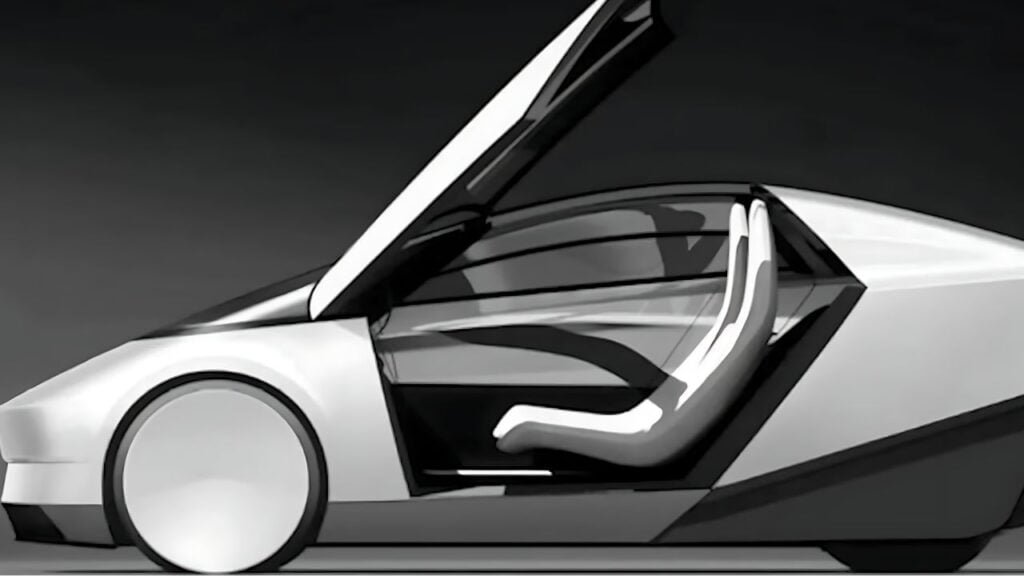
Aerodynamic Teardrop Shape
The Model 2 is expected to adopt a teardrop-shaped design, considered one of the most aerodynamic shapes for cars. This design is reminiscent of the innovative three-wheel vehicle by Aptera, known for its minimal rolling resistance and drag coefficient.
For context, a Toyota Corolla has a drag coefficient of 0.29, while the Tesla Model 3 achieves 0.23. The Aptera boasts an impressive 0.13, comparable to the drag coefficient of a bottlenose dolphin at 0.1. Transitioning to three wheels reduces the number of touchpoints and areas where energy can be lost, contributing to enhanced efficiency. The Model 2 could potentially integrate unconventional features like unique headlights and the elimination of a traditional trunk, emphasizing Tesla’s commitment to radical efficiency and forward-thinking design.
Read – 10 Problems With The 2024 Tesla Cybertruck That Elon Musk Won’t Tell You
Door and Body Design Changes
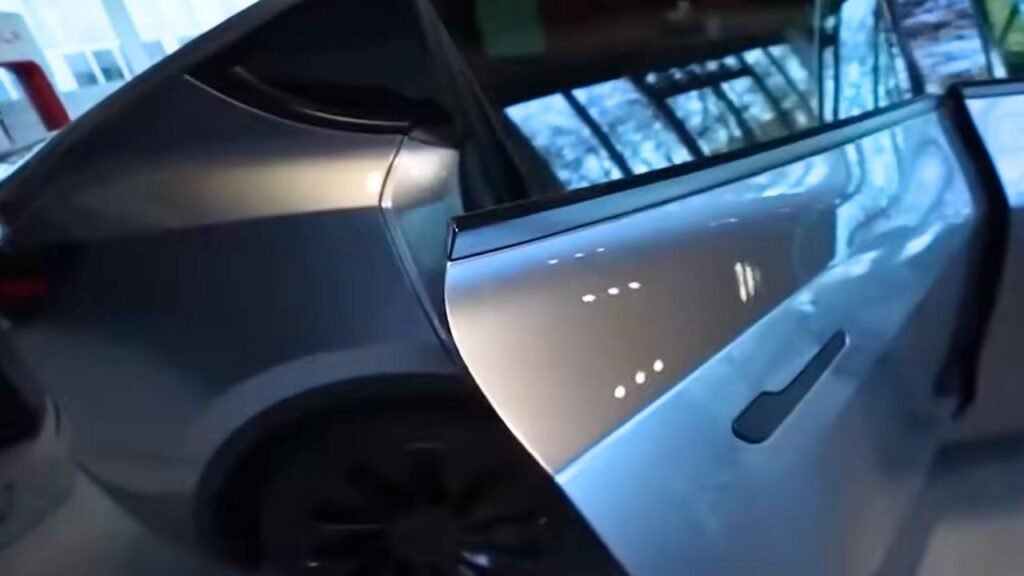
Tesla might explore a simpler and more cost-effective two-door configuration for the Model 2, similar to Volkswagen’s XL1 car concept with its futuristic gullwing doors. Alternatively, a two-seater design could be considered, akin to a business version of the Model Y developed for the French market.
This two-seater Model Y offers a spacious storage capacity of 2,158 liters (76 cubic feet) and a range of up to 565 km (351 miles) on the WLTP cycle. If Tesla incorporates these innovative design elements into the Model 2, it could achieve an impressive range of 450 miles on a single charge.
Fender Skirts for Improved Aerodynamics
Another potential feature is the use of fender skirts to cover the rear wheels, which could further streamline the Model 2’s aerodynamics and extend its range. For instance, by covering the rear wheel with fender skirts, the original Honda Insight from 1999 could achieve a drag coefficient of 0.25. Utilizing fender skirts could enhance the Model 2’s aerodynamics, thus extending its range. However, this would require certain design adjustments, such as using narrower rear tires to ensure safety and optimal handling.
Interior Design: Streamlined and Minimalist
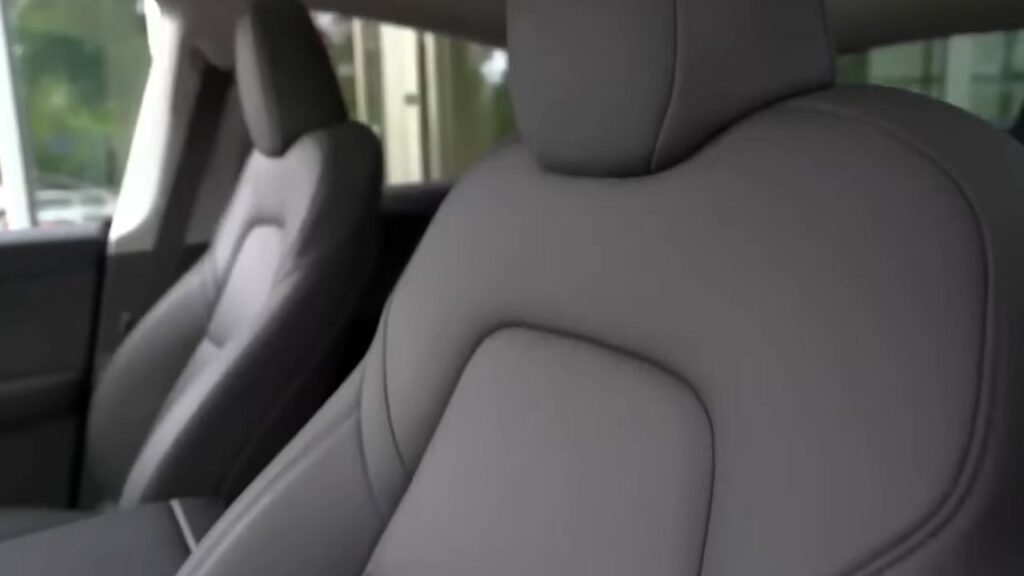
Simplified and Budget-Friendly
The Model 2’s interior is expected to resemble a scaled-down version of the Model 3 or Model Y, with an even more streamlined minimalist design. While luxurious features like heated or ventilated seats may be excluded to maintain affordability, Tesla might offer these as optional upgrades for residents in hot climates.
Ventilated seats, originally exclusive to Tesla’s higher-end models like the Model S and Model X, were introduced in the Model 3 Highland edition due to demand from Model 3 and Y users. Currently, the Model Y does not offer ventilated seats, but there is hope that an upcoming Model Y refresh will include this feature.
Steering Wheel and Dashboard

Tesla is likely to opt for a less controversial steering wheel design for the Model 2, possibly adopting a circular wheel or a hybrid design similar to the Cybertruck’s steering wheel. The Model 2 is expected to feature a traditional horn and a large infotainment touchscreen, consistent with previous Tesla models. This touchscreen is likely to be around 15.4 inches in size, similar to that of the Model 3.
To reduce costs, the rear touchscreen may be omitted, and the dashboard might feature a long LED strip light for a blend of simplicity and futuristic aesthetics. Given that the Model 2 is a budget-friendly car, it may not feature unique dashboard textures like ABS bonded foam, non-woven fabric, or Alcantara. Instead, Tesla could opt for a wood trim similar to older designs of the Model 3 to maintain affordability while providing a premium feel.
High-Tech Features: Leading the Way in Autonomy
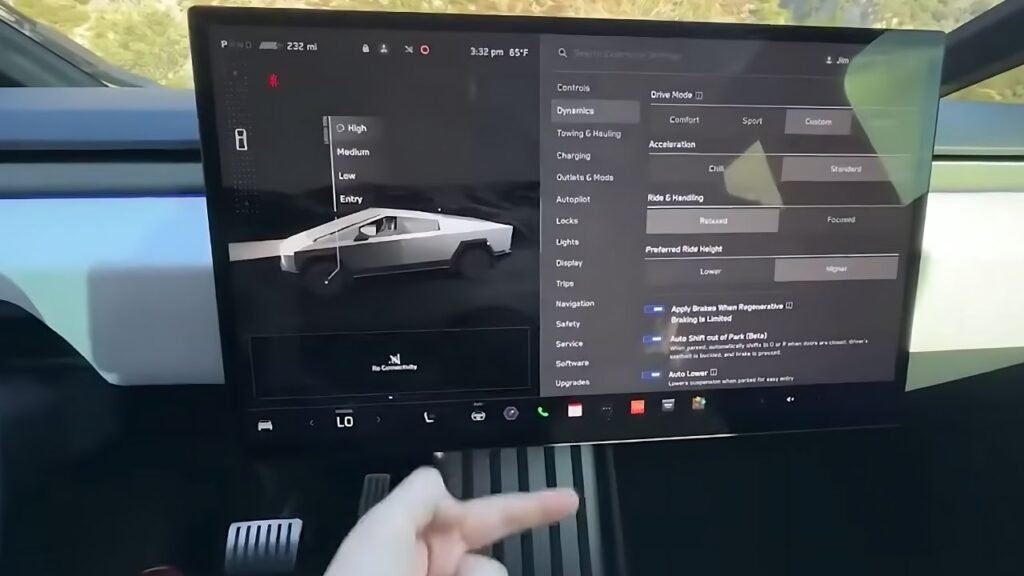
Full Self-Driving (FSD) Version 12
The Model 2 is poised to be one of the most high-tech Tesla cars ever, equipped with the latest version of Full Self-Driving (FSD) software. Elon Musk emphasized the rapid improvement of FSD, which is now activated on all vehicles equipped with cameras and an inference computer. Tesla has significantly expanded its core AI infrastructure, installing 35,000 H100 GPUs, with plans to increase this number to 85,000 by the end of the year. This development underscores Tesla’s commitment to advancing autonomous driving technology and leveraging cutting-edge AI capabilities.
In conclusion, full self-driving (FSD) represents a key selling point for Tesla vehicles. With FSD’s rapid development pace and advancements in AI, the Model 2 will come equipped with the latest version of FSD, offering an autonomous driving experience that surpasses human capabilities.
Read – Middle Class CRUSHED by Biden’s Electric Vehicle Strategy!
New Drive Unit and Battery
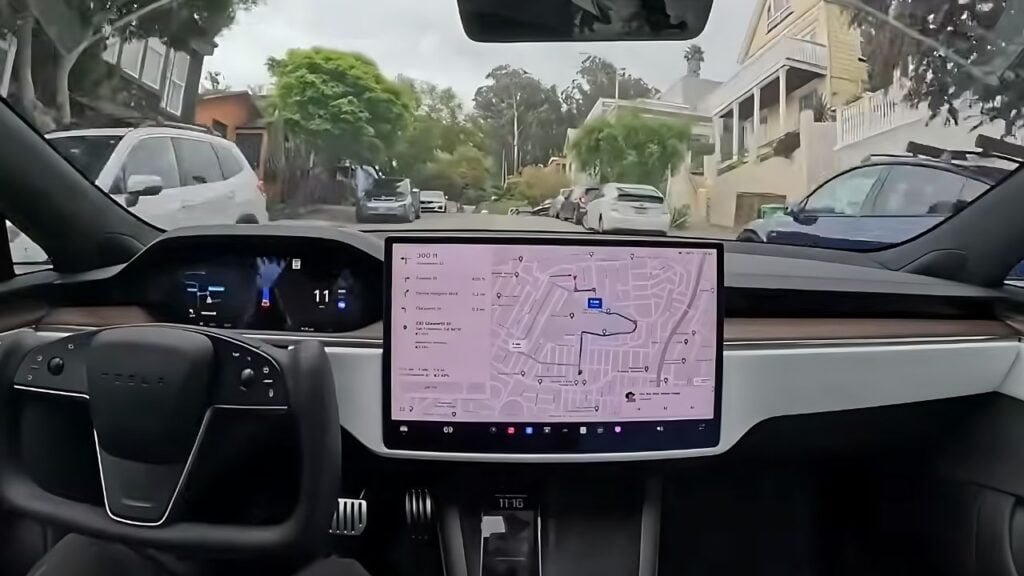
Tesla aims to introduce a new drive unit for the Model 2, focusing on reducing the use of rare earth materials and enhancing efficiency. The company’s goal is to achieve a 75% reduction in silicon carbide without compromising performance or efficiency. This announcement was made on March 1st, 2023, with Tesla planning to incorporate this drive unit technology into the $25,000 Model 2. Additionally, Tesla will utilize a 48-volt low-voltage infrastructure in the Model 2, a transition from the traditional 12-volt system, starting with Cybertruck and Optimus, and following in all future Tesla models.
Lastly, Model 2 is expected to offer a range of around 250 to 300 miles, aligning with Tesla’s current standards and competitive benchmarks. To achieve this range while simultaneously keeping costs low, Model 2 is likely to utilize LFP batteries from CATL. Recent reports suggest a deepening partnership between Tesla and this battery supplier, with CATL supplying battery tooling to Tesla’s Gigafactory in Nevada. Rather than importing battery module tools or raw materials directly, Tesla is speculated to lease tooling from CATL and collaborate on new battery chemistries.
Robin Zeng, chairman of CATL, confirmed to Bloomberg that the companies are working on new electrochemical structures to enable faster battery recharging. Right now, not much detail is revealed about this battery, so we will have to wait until August 8th, when Elon Musk is expected to disclose more details about Model 2 during the Robo Taxi unveiling.
However, according to the latest confirmation from Elon Musk, the Robo Taxi plan has been delayed, and a new timeline has not yet been confirmed. Musk wrote on X, “Requested what I think is an important design change to the front, and extra time allows us to show off a few other things.” It looks like the Robo Taxi still needs some adjustments, as Elon mentioned, so let’s wait and see how they handle it.
Battery Innovations
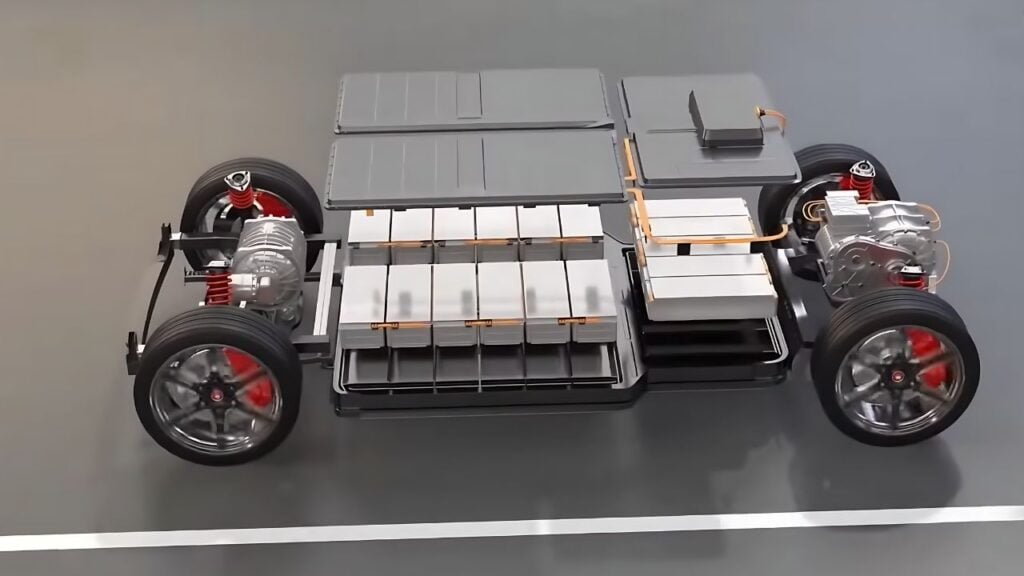
What is Special About the New Model 2 Battery?
The chairman of CATL, the world’s biggest battery maker, Robin Zeng, announced that the company is in the process of developing faster charging batteries for Tesla. This effort aligns with Tesla’s goal of defending its market share and introducing a car priced at under $25,000, known as the Redwood or Model 2. According to the South China Morning Post, Tesla plans to expand battery production in Nevada by opening a small facility utilizing idle equipment from CATL.
This facility will be fully controlled by Tesla, with the company covering 100% of the costs, and CATL personnel will be uninvolved other than helping to set up the equipment. This arrangement ensures that Model 2 remains qualified for the tax credit, as its battery will still be considered domestically made. Tesla’s competitor, Ford, is also taking similar steps. In February, Ford CEO Jim Farley announced at a press conference that Ford Motor Company will partner with CATL, investing $3.5 billion to create an electric vehicle battery plant in Marshall, Michigan.
Advantages of LFP and M3P Batteries
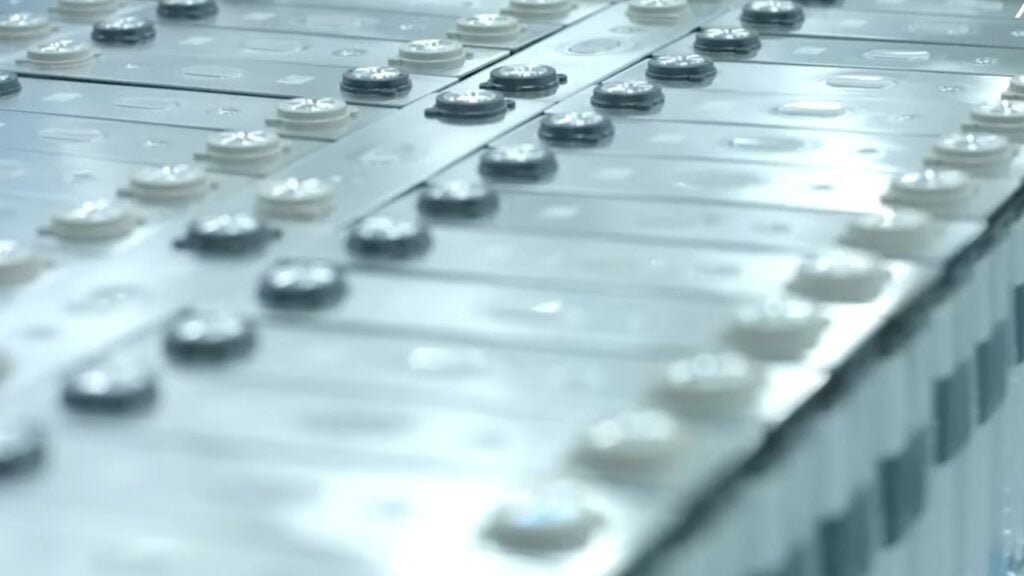
Initially, Tesla’s master plan part three indicated that the Model 2 would utilize LFP cells alongside a 53 kWh battery. The advantages of the lithium-ion phosphate chemistry include significantly cheaper battery packs coupled with enhanced safety features. Additionally, LFP cells offer a high working voltage, extended cycle life, lightweight design, and rapid charging and discharging capabilities. However, LFP cells are known for their lower energy density. CATL has tackled this challenge by introducing a pioneering solution, the M3P battery, anticipated to be integrated into future Tesla models.
As per reports from China EV Post, the M3P battery showcases an impressive energy density of 210 Wh/kg, representing a 15% increase compared to traditional lithium-ion phosphate batteries. In addition to the M3P chemistry, CATL has already teased a new fast-charging LFP cell designed with superior cold weather performance in mind, known as the Shenkang battery.
This innovative battery technology is generating significant buzz due to its remarkable capabilities. It has been reported that the Shenkang battery can add 400 km of range in just 10 minutes of charging. Even in extremely cold temperatures as low as -10°C, it can achieve a 0 to 80% charge in only 30 minutes, matching the charging speed of other EVs in normal temperatures. Given the impressive performance of the Shenkang battery, there is anticipation that the Model 2 battery may incorporate similar advancements or even surpass them.
Technological Innovations: Efficiency and Cost Reduction
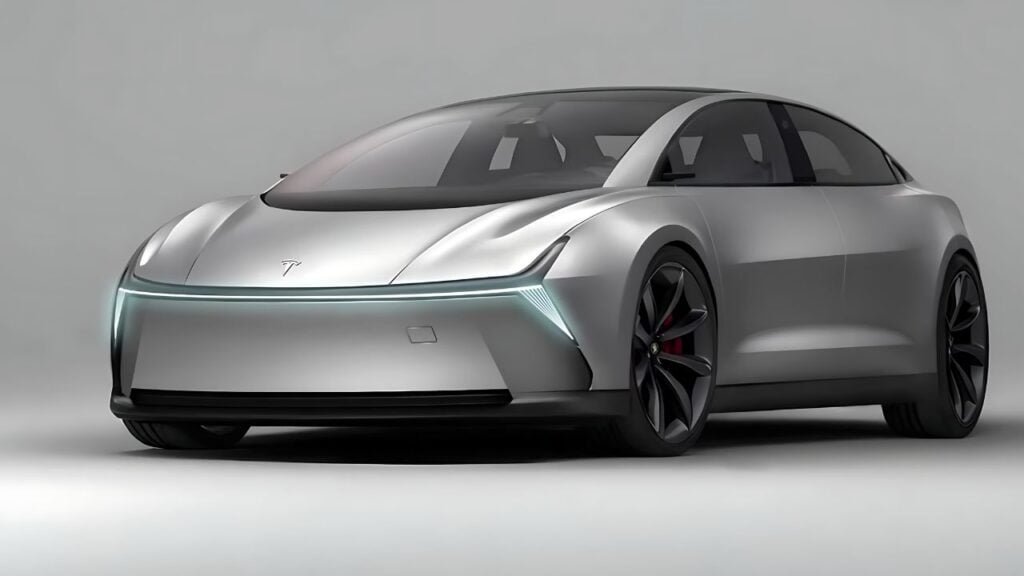
Unboxing Manufacturing Process
Tesla’s new unboxing manufacturing process is designed to revolutionize vehicle assembly. Instead of following the traditional order of operations, Tesla will construct complete assemblies first and then integrate them to finish the car at the end of the line. This approach aims to streamline production, enhance efficiency, and significantly reduce costs. Achieving such ambitious goals would signify a substantial advancement in automotive manufacturing efficiency.
New Motor Technology
Tesla’s new motor technology eliminates the need for rare earth elements, addressing environmental concerns and reducing costs. The company’s innovative stator design facilitates easier and more efficient manufacturing processes, aligning with the Model 2’s emphasis on cost reduction and production speed. Tesla holds nearly 200 patents related to electric motors, with 51 specifically focusing on the stator. Many of Tesla’s stator patents revolve around automation.
For instance, Tesla’s patented stator uses regular round cross-section wires, which are less expensive and easier to obtain than the square cross-section wires required for hairpin stators. The stator also features a unique radial arrangement of teeth around a central axis, facilitating easier and more efficient winding of coils on the stator’s inward portions. Additionally, the stator incorporates wedge members placed between the teeth to secure their position and possibly enhance the magnetic flux path, contributing to the motor’s efficiency and performance. These innovations align with the Model 2’s focus on cost reduction and efficient production.
Federal EV Tax Credit
The Model 2 will likely benefit from the federal EV tax credit, potentially lowering its cost by up to $7,500. Tesla’s Nevada facility is expanding battery cell production with equipment from CATL, ensuring the new battery is considered domestically made. This setup allows the Model 2 to qualify for the full tax credit. The tax credit, worth up to $7,500, consists of two components: battery requirements and sourcing requirements, each accounting for half of the credit. If the car meets both requirements, it is eligible for the full credit.
If it meets only one, it may qualify for a partial credit of $3,750. Tesla’s Nevada facility, which is expanding its battery cell production with equipment from CATL, ensures the new battery is considered domestically made. This arrangement allows the Model 2 to potentially meet the requirements for the full tax credit. For the other half of the credit, most materials for the Model 2 need to be sourced from America. The Cybertruck, for instance, is one of the most American-made EV pickups, with 65% US plus Canadian parts content and 25% of foreign parts content from Mexico. It’s reasonable to expect the Model 2 to follow a similar approach.
Optimus Robot Integration
Tesla plans to deploy thousands of Optimus robots in its factories to handle tasks like moving cells off the production line. This robot army will help accelerate the rollout of the Model 2 and other future Tesla cars, maintaining maximum production speed while keeping costs low. According to Elon Musk, Tesla has already deployed two Optimus robots in the Fremont factory to handle tasks such as taking cells off the line and placing them in shipping containers.
The plan is to have a few thousand robots working at Tesla next year. Musk believes there will be at least one robot per human, with the potential to produce 1 billion robots per year, selling them at a price of $20,000 per unit. Currently, Giga Fremont, being Tesla’s first gigafactory, serves as an ideal testing ground for Optimus. This is a crucial step before Tesla can scale up and deploy robots in production at its other factories.
The bots now function automatically, marking impressive progress considering that just one month ago, Optimus was still sorting batteries but required some assistance from humans. Once the robots can match the speed of human workers, Tesla could triple the number of cars it rolls out from each factory, as these humanoid robots can work three shifts a day without getting tired.
Additional Cost Reduction Strategies
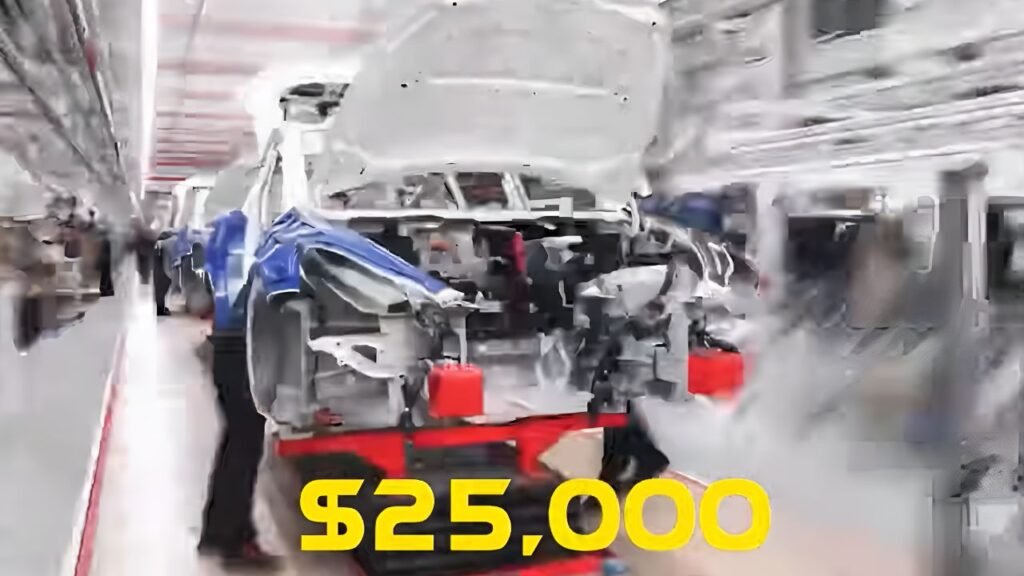
What Else Does Tesla Do to Further Lower Costs?
Let’s begin by discussing chips. Electronic systems powered by semiconductor-based chips comprised 40% of the cost of a new car in 2017, and this percentage has only increased since then. Currently, the cost of EV chips is gradually surpassing the price of batteries. Additionally, in the US, computer chip tariffs are set to double to 50% by 2025, which will increase material costs for EV makers and lead to higher prices for consumers. However, this won’t be the case for the Tesla Model 2 and future models.
Elon Musk announced that Tesla has started building its own chips from scratch, meaning they will no longer rely on suppliers like Nvidia, Samsung, and TSMC. This move will significantly reduce costs and help keep the price of the Model 2 and future Tesla vehicles more affordable. The Model 2 will also mark Tesla’s adoption of the unboxing manufacturing method. According to Tesla, this innovative approach has the potential to slash costs by 50% and reduce the necessary manufacturing footprint by over 40%.
The Unboxing Process
The traditional way of making a vehicle involves stamping, building a body in white, painting, and final assembly. These steps are dictated by the organizational structures and boundaries of the factories. If something goes wrong in final assembly, it can block the whole line, resulting in buffering in between. The unboxing process revolutionizes vehicle assembly by flipping the traditional order of operations.
Rather than beginning with the body and integrating interior components and the battery later, Tesla’s new method involves first constructing complete assemblies, such as the front, rear, sides, and interior, and then integrating them to finish the car at the end of the line. This approach aims to streamline production, enhance efficiency, and potentially reduce costs significantly by optimizing workflow and minimizing assembly complexities.
Competitors: The Race for Affordable EVs
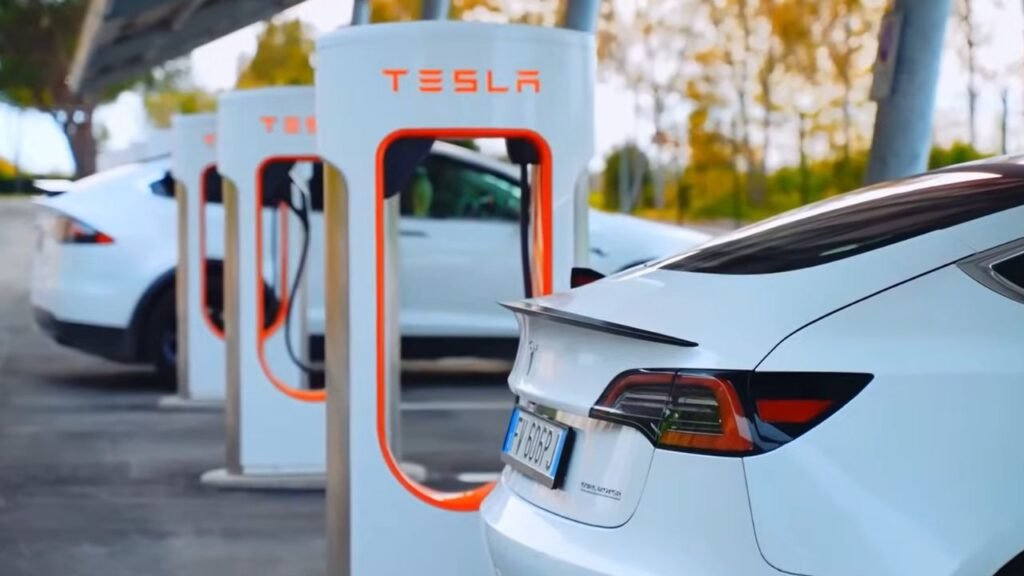
General Motors’ Effort to Revive the Chevy Bolt
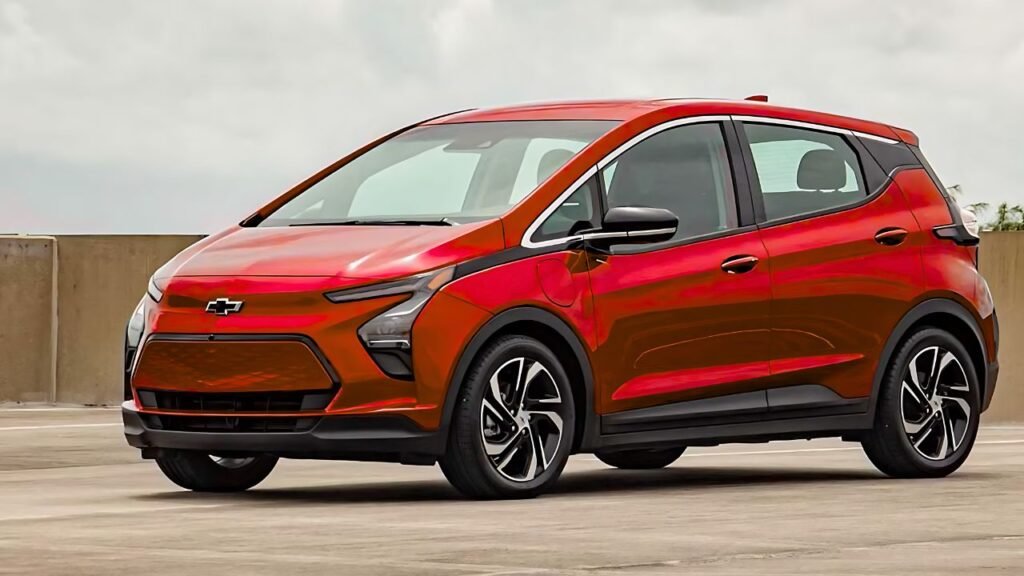
In the competitive race to launch affordable electric models, GM is positioning itself with a bold strategy. Marissa West, GM’s new North American president, has expressed confidence that the next-generation Chevy Bolt EV will become the most affordable vehicle on the market by 2025. GM CEO Mary Barra has confirmed plans for a next-generation Bolt EV based on the Ultium platform. Barra emphasized that this new Bolt will offer an even better driving, charging, and ownership experience.
The vehicle will utilize the new North American Charging Standard, ensuring compatibility with Tesla’s superchargers. Additionally, it will feature low-cost lithium-ion phosphate batteries integrated into GM’s Ultium EV platform. In the meantime, GM is launching a series of new electric models, including the new Chevy Equinox, Blazer, and Silverado EVs, all based on the Ultium platform. With the original Bolt discontinued last December, GM is gearing up to reintroduce its most popular EV back into the market by 2025 to meet the growing demand for affordable electric vehicles.
In 2023, GM reported a record 62,045 sales of the Bolt and Bolt EUV combined, marking a significant 63% increase compared to 2022. The Bolt has been pivotal as an entry-level vehicle for Chevrolet, with over 70% of buyers switching from non-GM vehicles to purchase a Bolt. It has consistently been the leading EV alternative to Tesla in the US for the past 7 years. Despite its reputation for modest ride quality and a limited range of 278 miles, along with slower charging speeds of 61 minutes, the Bolt has garnered a dedicated following due to its unbeatable starting price of $26,500 before incentives.
GM has not yet disclosed pricing for the new Chevy Bolt EV, but it will need to undercut this previous price to claim the title of the most affordable on the market. While specific details regarding price and specifications are still forthcoming, the new Chevy Bolt EV is poised to be a strong contender in the $25,000 EV class, potentially offering competitive range and features for its price point.
Will Ford Return to the Game?
Amid a slowdown in US electric vehicle sales, Ford Motor Co. has announced plans to postpone the introduction of new electric pickup trucks and a three-row electric SUV until 2026 and 2027, respectively. This decision comes as Ford expands its model lineup to include gas-electric hybrids. Does this mean Ford has completely given up on the EV market? The answer is no. Ford’s CEO Jim Farley admitted that larger EVs, such as the F-150 Lightning, are costly to build.
He stated, “What the customer has now said to us is if you have anything larger than the Escape, it better be really functional or a work vehicle as an EV. On the other hand, with smaller EVs, it’s totally different.” Farley mentioned that with an Escape-sized electric car or smaller, it completely works. That’s why Ford has shifted its focus from large electric SUVs and trucks, which are deemed too expensive for mainstream customers, to smaller electric vehicles.
Ford’s leadership stated on the company’s earnings call that they made a bet in silence two years ago to develop a low-cost EV platform that will serve as the foundation for multiple vehicle types. It’s worth noting that this project operates independently from Ford’s core operations. According to Bloomberg, the development work is led by a team of engineers based in Irvine, California, overseen by Alan Clarke, who previously directed engineering for Tesla’s Model Y SUV. The first of three new EVs made on that platform, including a small SUV, small pickup, and a ride-hailing vehicle, will arrive in late 2026 with a starting price around $25,000, according to reports initially from Bloomberg Businessweek and later confirmed by CEO Jim Farley.
He stated that Ford’s new goal is clear: to create mainstream EVs that are profitable within a year on the market. This stands in stark contrast to the losses incurred by its current lineup. For comparison, last year alone, Ford reported losses of $4.7 billion on EVs, translating to approximately $32,000 for each EV sold. With the introduction of a new platform and the upcoming release of three new car models in late 2026, Ford is positioning itself to potentially turn around its current situation and contribute alongside Tesla and GM to accelerating EV adoption in the future. It’s crucial for Ford to avoid the pitfalls experienced by startups like Fisker, which recently filed for Chapter 11 bankruptcy protection. Fisker’s challenges stemmed from lackluster consumer demand, substantial cash burn, and operational and product issues.
What Will Stellantis Bring to the Table?
Carlos Tavares, CEO of Stellantis, has affirmed the company’s mission to provide clean, safe, and affordable EVs to consumers. Despite previous delays in introducing electric models in the US market, Tavares announced plans to launch a $25,000 electric Jeep very soon as part of a comprehensive EV initiative. This announcement was made during a Bernstein conference on May 29th.
Bloomberg later reported that Stellantis confirmed the EV would adopt the Jeep Renegade brand and would be one of at least three new Jeep models expected to be available for sale in the US by 2027. The Renegade, introduced as a combustion model in 2014, is classified as a mini SUV and is manufactured alongside the Fiat 500X and Jeep Compass at the Melfi plant in Italy. Currently, the Renegade is priced starting at less than $30,000 in the US market. With the introduction of the $25,000 electric counterpart, it would become the cheapest Jeep available in the US, undercutting the gas-powered Jeep Compass compact crossover, which starts at approximately $26,000.
Conclusion
The 2025 Tesla Model 2 Redwood is set to revolutionize the market for affordable electric vehicles. With innovative design, cutting-edge technology, and strategic cost-reduction measures, Tesla is poised to make electric vehicles more accessible and competitively priced. As other automakers follow suit with their affordable EV offerings, the future of electric mobility looks promising.
As of April 2024, the average transaction price for electric cars stood at $55,940, compared to $44,988 for gas-powered vehicles. With the imminent release of new models over the next three years, this dynamic could potentially shift, making electric vehicles from Tesla more accessible and competitively priced in the market. Currently, other markets already have their affordable electric models, such as the BYD Seagull at $10,000 in China, the Dacia Spring starting at $20,000 in Europe, the Renault Kwid E-Tech priced at $19,000 in Brazil, and the Kia Ray at $22,000 in South Korea. It’s exciting that the US market is following this trend.
So, what do you think about the Tesla Model 2? Leave a comment below and let us know your thoughts. If you enjoyed this blog post, don’t forget to give us a like and share it with others. Goodbye and see you soon!
